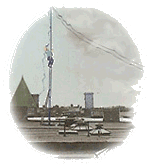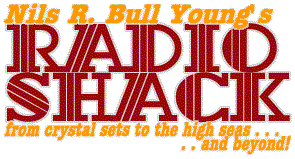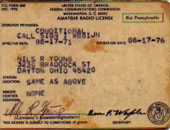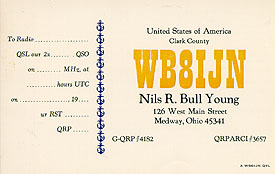
Radio in the fleet was much like radio in
Puerto Rico. The difference was a matter of mass. The Sara was an aircraft
carrier, one of those long, flat-topped ships sporting 2,000 crew members,
86 airplanes, four catapult tracks and a firetruck. There were at least
three rooms full of radios that listened to nothing but HF (3-30 MHz) traffic. Another
room held enough VHF radios to listen to every airplane on the flight deck.
And two rooms full of transmitters. There was a lot more mass in radios
on the Sara than I had ever seen in Puerto Rico.
But there was room
enough for me. And there was a ham radio set up aft on the portside, just
forward of the last bulkhead, before the first arresting cable. Eventually
I gained access to that space and
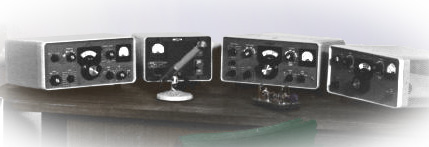
spent
the rest of my USN underway and in-port time playing with a Collins S-Line
& one of the Sara's 32 ft vertical whip antennas.
It was actually
a pretty cool way to spend the five months of a Med cruise. I didn't have
palm trees and island verdure on the Sara, but I had a heck-of-a-better
station than the simple set-up that I'd cobbled together in Puerto Rico.
Only one problem: phone patches.
Not that I didn't
know how to do 'em. It's just that once the rest of the crew found out
about the ham shack being open again (it had been left untended for probably
the better part of the year I was on the Sara), they lined up at the door
wanting to "call home."
There was even a
guy who had a "head of the line chit" from the chaplain, on the grounds
that he was suffering from the long-term
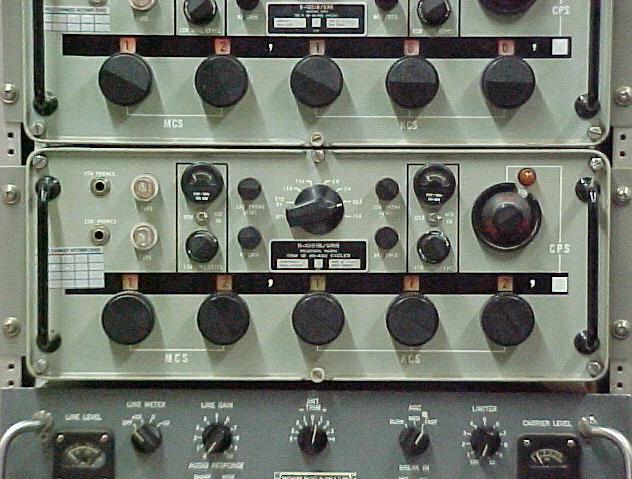
separation
from his wife & he had a tendency to get nutty because of it. (More
like he would send her thoughtless, mean letters accusing her of sleeping
with the fleet and then suddenly have a change of heart about two days
after the mail plane left . . . at which point he'd go to the chaplain,
whine and weedle a bit and then show up at the shack door wanting to tell
his wife not to read the letters that he'd just sent to her.
At any rate, I soon
enough figured out how to get out of running phone patches: I claimed that
my license had been modified so that I could
no longer run patches and besides, the comm officer controlled the spaces
and he had placed a limit on the "on-air" time that the room was allowed
to have.
Which left me with
a lot of time to play CW. It was really quite a deal, what with me being
unable to say what ship I was on or where in the universe I was posted.
I could only say that I was on a USN ship in whatever maritime region I
happened to be. My name & callsign were supposed to be the limit. It
made for very bizarre
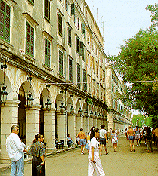
conversations,
especially with DX stations (which meant, even in Europe, almost anyone
on the planet) who wanted to know all the hairy details.
Another things that
was weird was the guys who I met on CW. Most of 'em were nice enough folks,
not too cranked up on high-speed CW. But every now and then, after saying
that I was in the USN, one or the other of 'em would crank up the CW speed
to see if I was really salty enough. In some ways it was a joke. I could
copy easily 20 WPM back then, mostly from just being on the air with
it or hearing it all the time (sometimes in my sleep). It's just that it
got to be a kind of game: see if I can snow the sailor.
At the end of the
cruise, everything was nominally back to normal, and I also got access
to the Mayport Naval Station ham radio club set up. Nice Drake gear. Serious
antennas. A lot of fun. And then there was the little TRC77 military surplus
rig in my beach apartment. Which leads directly into QRP, except I ain't
finished tellin' you about the ham radio stuff quite yet . . .
Back to Civilian Life Again
Updated 25 July 2004
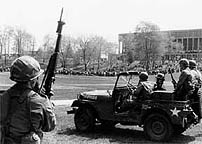
Woodstock, the Kent State killings, the escalated
Vietnam War bombings and subsequent public protests all happened in the
late 60s,
when I was in Puerto Rico. I read about the events or heard about them
second hand from others who listened to the local AFRTS radio station or
got local newspapers from home.
My only sure knowledge
of it was reading about them in the American Radio Relay League's publication,
QST. In those pages I read about younger hams, mostly at protest-ridden
colleges around the US, who had set
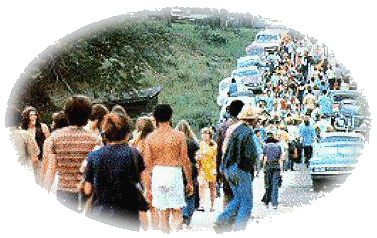
up
nets & discussion groups on the air to keep track of and keep people
informed of the events. The ARRL editorialized dead against the practice.
The nets, however,
continued, often against the noisy interference of other
hams who sided with the ARRL or who felt that politics should be kept off
the ham bands. After all, the argument went, it was part of the ham's operating
code: "No politics, no religion, no sex, no swearing."
The protests & violence continued unabated and the radio nets continued. For me in Puerto
Rico or on the USS Saratoga in the Mediterranean, it was all moot point.
But on 18 March
1972, when I signed out of the active-duty Navy and returned to being what,
was for me & at long last, a civilian, all of that changed. I moved
my radio junk into the basement of my parents' house & started getting
acquainted with the "local gang." Among the first people I met was the
Ohio Valley Teenage Net. The fact that most of the members were well out
of high school was of little importance to me then, and I gladly joined
in their radio madness. Well, as much as I could, working nights &
afternoons at the local newspaper. The same one where my father worked
until his retirement.
At some point along
this time line, I moved into an apartment shared with a former college
friend & tried to set up my Argonaut & homebrew
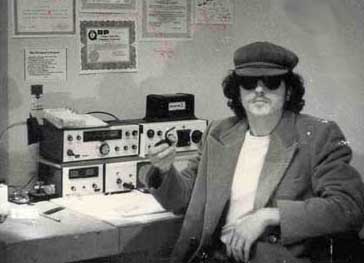
accessories
in a small bedroom. It was fun for a while & I got to have a few dozen
QSOs with people around the country but seldom around the world.
And then there was
the Dayton Hamvention, which I learned about from Mike Suhar, WB8GXB, whom
I met on 20m one afternoon while calling CQ. I went to that first civilian-issue
Hamvention with my father. Dad considered all the expensive equipment and
was impressed. He told me about the broadcaster he had worked
at once in his youth.
The owners had set
up studios in a house. The studios were in the various bedrooms and the
transmitter had ended up in the bathroom where a bath tub had previously
been. Dad said you could sit on the can & watch the mercury vapor rectifiers
glow & pulse in time with the modulation peaks.
station
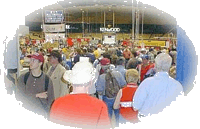
But 1972's Hamvention
was the only one to which Dad ever went. It was a trying thing for him,
keeping up with my youthful exuberance taxing his already slower rate of
progress. We had to stop a couple times to just sit and let him catch his
breath.
The radio station was
still in there. It was just slowing down, which is another story,
further on, but another story just the same . .
which leads to the next page.
